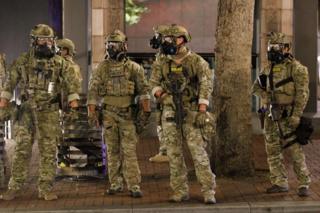 Image copyright
Getty Images
Image copyright
Getty Images
After protests spread across the US following the death of George Floyd, President Trump threatened to send in the army to end the unrest.
Mr Trump said he has the power to send in the military if cities and states fail to solve the problem themselves.
If a city or a state refuses to take the actions that are necessary...then I will deploy the US military
Protests have continued in Portland, Oregon, for more than 50 days - and the city's mayor says there are "dozens, if not hundreds, of federal troops" deployed there who aren't welcome.
It's unclear if the camouflaged federal forces in Portland are military personnel, but state governors are questioning if the federal government has the authority to send in troops without their permission.
Can the president deploy troops?
In short, yes he can under certain circumstances.
The federal government has deployed thousands of troops from the National Guard, a reserve force for the US Army, to quell protests on request from cities or states themselves.
However, a US law passed in the 19th Century lays out circumstances when the government in Washington DC can intervene without state authorisation.
The Insurrection Act says the approval of governors isn't required when the president determines the situation in a state makes it impossible to enforce US laws, or when citizens' rights are threatened.
The law was passed in 1807 to allow the president to call out a militia to protect against "hostile incursions of the Indians" - and it was subsequently extended to allow for the use of the US military in domestic disturbances and to protect civil rights.
Another law passed in 1878 requires congressional authorisation for domestic military use, but a legal expert told the BBC that the Insurrection Act was sufficient legal authority on its own for the president to deploy the army.
"The key point", says Robert Chesney, a University of Texas law professor, "is that it is the president's determination to make; the governors do not have to request his help."
However, Mr Trump's suggestion that he might use the Insurrection Act to quell the unrest following the death of George Floyd has previously been questioned by his own defence secretary Mark Esper.
Mr Esper said: "The option to use active duty forces in a law enforcement role should only be used as a matter of last resort, and only in the most urgent and dire of situations."
Has the law been used before?
According to the Congressional Research Service, the Insurrection Act has been used dozens of times in the past, although not for almost three decades.
It was last invoked in 1992 by former US President George HW Bush during riots in Los Angeles, after the governor of California requested federal help.
The law was used throughout the 1950s and 60s during the civil rights era by three different presidents, including when there were objections from state governors.
President Dwight Eisenhower faced objections when he used the law in 1957 to send US troops to Arkansas to control a protest at a school, where black and white children were being taught together.
Since the end of the 1960s, the use of the law has been rare. Congress amended it in 2006 following Hurricane Katrina in an attempt to make military assistance more effective, but the amendment was repealed after state governors objected to it.